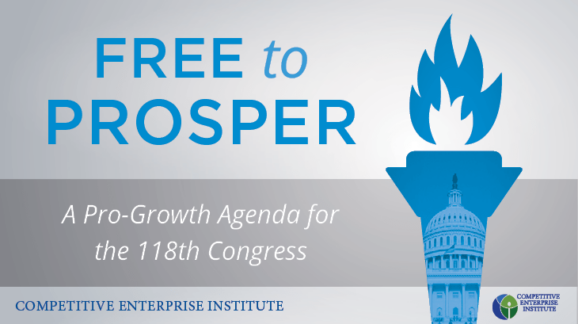Free to Prosper: Trade
Trade policy took a turn for the worse during the Trump administration, and the Biden administration has committed largely to the same course. Tariffs have doubled over the last five years. Non-tariff barriers are also increasing, such as labor, regulatory, environmental, and intellectual property provisions in international trade agreements that keep out various foreign goods. Such trade-unrelated provisions are now standard fare in new trade agreements, including the United States-Mexico-Canada Agreement (USMCA). Notice that the USMCA, which replaced the North American Free Trade Agreement, or NAFTA, has neither “free” nor “trade” in its name.
Although neither party is enthusiastic about liberalizing trade, both parties have at least some free trade advocates. If they work together on trade, while agreeing to disagree on other issues, they can make positive changes. Such cooperation would result in more resilient supply networks and lower prices during a time of high monetary inflation and serve America’s foreign policy interests at a time when countering Russia’s and China’s influence is becoming more important.
Tariffs
In the short to medium term, Congress should reform trade laws to facilitate tariff relief. Lifting the Trump-Biden tariffs alone would lower consumer prices on hundreds of billions of dollars’ worth of goods, including cars, construction materials, groceries, clothing, smartphones, and semiconductors needed for a wide variety of manufactured products.
Congress should pass legislation ending the tariffs. President Biden has the authority to unilaterally repeal most of them. But those actions would treat only the symptom, not the root problem, which is an unbalanced separation of powers.
Taxing authority belongs to Congress, yet the Trump-Biden tariffs were mostly enacted by the White House, without congressional involvement. In the 1960s and 1970s, Congress delegated some of its tariff-making powers to the president to prevent ongoing tariff relief efforts from being watered down by pork barrel spending projects, vote trading, and special-interest giveaways. That strategy has been coopted by protectionists. The time has come for Congress to reclaim its proper taxing authority from the executive branch.
To that end, Congress should repeal Section 232 of the Trade Expansion Act of 1962, which President Trump used to enact steel and aluminum tariffs—against allies—on dubious national security grounds. Congress should also repeal Sections 201 and 301 of the Trade Act of 1974, which Trump used to enact tariffs against China, Europe, and other countries.
Industrial policy is often protectionism under another name, and Congress should resist its temptations. The Creating Helpful Incentives to Produce Semiconductors (CHIPS) Act, which was passed in the last Congress, is intended to make America’s semiconductor policy more competitive with China’s. It will instead copy China’s state-centered economic approach, which has kept Chinese chip producers a decade behind the rest of the world.
Domestic producers did not need the help, despite a chip shortage. Production was increasing and new facilities were under construction well before the CHIPS Act was proposed. The CHIPS Act’s precedent will encourage other industries to look to Washington, rather than the marketplace, for profits. Industrial policy can create trade conflicts with allies as well as rivals and hinder American economic and foreign policy goals.
Industrial policy and corporate welfare make industries soft, dependent, and fragile. Liberalization would force industries to be accountable, competitive, and adaptable to changes.
Rules-Based International Trading System
In the long term, Congress should work to restore the rules-based international trading system, which has been under considerable stress in recent years. The General Agreement on Tariffs and Trade and its successor, the World Trade Organization, slowly but steadily reduced global trade barriers over a 75-year period, lowering prices and helping millions of people rise out of poverty. The United States alone had a roughly 85 percent success rate in cases it brought to the WTO’s dispute resolution system.
This system is currently unable to operate due to a lack of judges for its appellate system and might be abandoned in favor of bilateral and regional agreements. The United States is in the early stages of negotiating trade agreements with the United Kingdom, European Union, and other countries. Although these agreements tend to add complexity and bureaucracy due to increasing trade-unrelated provisions, they still tend to liberalize trade on net and are worth pursuing.
If the WTO continues to struggle, the United States could spearhead an effort to create a WTO-like organization, with membership restricted to democracies, and including an analog to the WTO’s valuable dispute resolution system. Meanwhile, authoritarian governments such as those in Russia and China would be unable to gum up the works of an organization of which they are not members. Protectionists who temporarily gain power in liberal countries would have their most destructive impulses thwarted due to the difficulty of finding enemies to rail against in an organization almost exclusively composed of allies.
In the meantime, Congress should commit America to rejoining the Trans- Pacific Partnership, which would provide an important economic and diplomatic counterweight to China. President Trump pulled out of the agreement early in his term, and President Biden has made no effort to rejoin it. It is carrying on without
American involvement as the Comprehensive and Progressive Agreement for Trans- Pacific Partnership. Congress can direct the president to do so as part of a compromise fast-track trade authority delegation that would also direct the president to pursue further trade liberalization agreements.
That delegation should also instruct the president to use his best efforts to restart the stalled Doha round of WTO negotiations, which has the potential to boost trade and global wealth to unprecedented levels.
